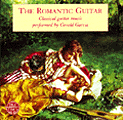The Romantic Guitar
Gerald Garcia Guitar
Notes
Recording Dates: 10-12 March 1997 in St.Martin’s Church, East Woodhay, Hampshire.
Recording Producer/engineer: John Taylor
Executive Producer: Tim Healey
Notes: ©G. Garcia 1997
Francisco Tarrega was not only the epitome of the guitar romantic, but was a genuine innovator for the instrument – he founded modern guitar technique, persuaded the guitar maker Torres to produce a larger instrument for use in concert halls, and produced numerous transcriptions and original works for the instrument.
Despite a painful eye condition (his eye lashes grew inwards), he travelled widely in Europe and performed in the Wigmore Hall in London. Capricho Ärabe and °Adelita! were among the first of his pieces to be published and have become classics of the guitar repertoire. His arrangements of themes from Verdi’s La Traviata, based on a novel by Dumas about the doomed affair of a consumptive courtesan, were written for an eccentric but rich Englishman by the name of Dr.Walter Leckie, who followed Tarrega around Europe when not working as a surgeon in the Chilean Army.
Another early fan of Tarrega’s was the Spaniard, Alberto Obregon, the son of a merchant who worked in Australia and South Africa before finally marrying an Englishwoman and settling in London. On hearing a performance of Tarrega’s, Obregon realised his own
shortcomings as a guitarist and immediately begged the maestro for lessons. The waltz A Ma Mie is dedicated to Tarrega after Obregon became part of London’s musical life, performing occasionally before King Edward and Queen Alexandra.
Napoleon Coste performed mainly in France and lived for some time in Paris, where he was able to mingle with the great guitarists of his day, and developed his own, highly romantic and virtuosic style of music exemplified by the Andante et Polonaise, which has the subtitle Souvenirs de Jura . Despite his evident skill as a musician, Coste made a living by being a civil servant in Paris, possibly as the result of an accident in which he broke his arm and was no longer able to perform in public.
Madame Sidney Pratten was born Catherina Pelzer, the daughter of an eminent guitarist . She created a stir in London society when she first began performing in public at the age of eight – in one concert, in which she played duets with the great Giulio Regondi (also
eight at the time) she and her partner had to sit on top of a grand piano in order to be seen! She later married a famous flautist, Robert Sidney Pratten, who unfortunately died soon after, but she kept the name and went on to be the teacher of Queen Victoria’s daughters, Princesses Louise and Beatrice, to whom she dedicated her Guitar Tutor, from which the Prelude, Daisy and the arrangement of The Last Rose of Summer are drawn. In all likelihood, she met the Irish poet Thomas Moore, who accompanied himself on the guitar and played his way into the hearts of Victorian drawing room audiences with his impassioned poems to Irish melodies (he was a friend of Sir Walter Scott).
Felix Mendelssohn of course did not write for the guitar, but he was Queen Victoria’s piano teacher, and the Venetian Gondola Song from Songs Without Words might well have been one of Her Majesty’s favorite pieces. My arrangement is in homage to Tarrega, who also heard the sound of the guitar evoked by the music’s calm accompaniment and mysterious melody.
One of Madame Sidney Pratten’s most talented students (Alberto Obregon was another) was Ernest Shand, whom she declared unable to teach, as he was her superior in technique and compositional skill. However, she was unstinting in her encouragement of the young Yorkshireman – she gave him music unobtainable elsewhere, and was the first publisher of his pieces. Shand, whose musical education began as a violinist with the encouragement of his parents, made a living as an actor in music halls and gave occasional recitals in his spare time to critical acclaim.
He was eventually persuaded by his wife and friends to take up the guitar professionally, but had to return to acting after spending a great deal on a studio and advertising in London.
He travelled as far as Australia as an actor and gave guitar performances there. On his return, he toured Britain and entertained the troops at the outbreak of the Great War. It was during one of these trips that he was attacked in his dressing room by an aggrieved Russian and sustained injuries which lasted until his death in Birmingham.
In this first recording of some of his music I hope to bring out the lyrical and gently interesting harmonic language of the most important composer for the guitar in England of his time, whose legacy extends to over two hundred pieces, including the first English guitar concerto.

